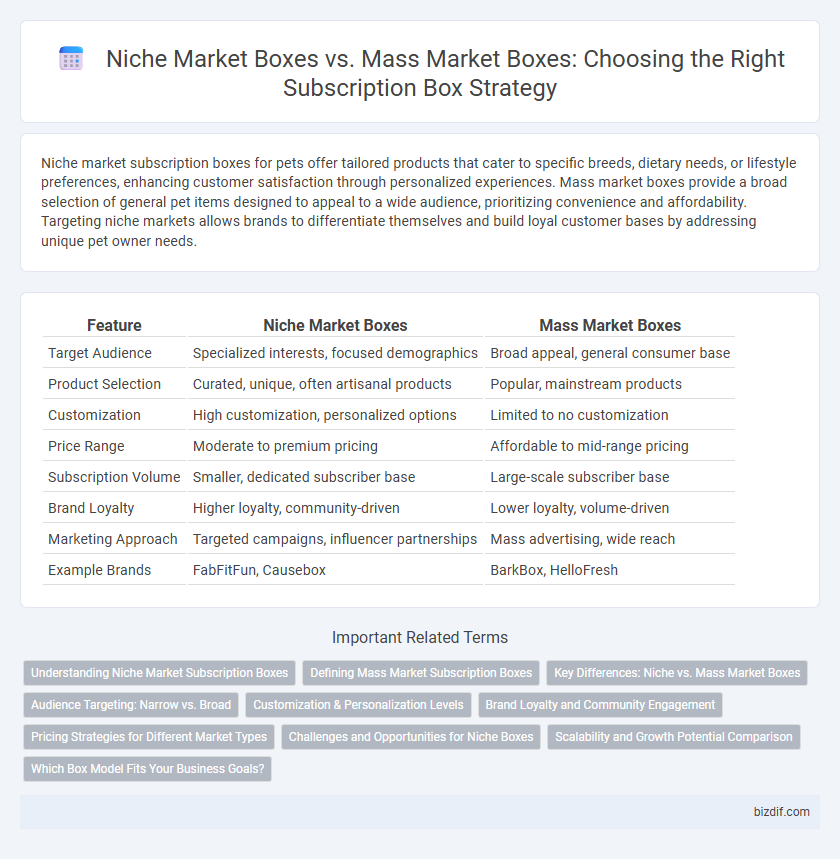Niche market subscription boxes for pets offer tailored products that cater to specific breeds, dietary needs, or lifestyle preferences, enhancing customer satisfaction through personalized experiences. Mass market boxes provide a broad selection of general pet items designed to appeal to a wide audience, prioritizing convenience and affordability. Targeting niche markets allows brands to differentiate themselves and build loyal customer bases by addressing unique pet owner needs.
Table of Comparison
| Feature | Niche Market Boxes | Mass Market Boxes |
|---|---|---|
| Target Audience | Specialized interests, focused demographics | Broad appeal, general consumer base |
| Product Selection | Curated, unique, often artisanal products | Popular, mainstream products |
| Customization | High customization, personalized options | Limited to no customization |
| Price Range | Moderate to premium pricing | Affordable to mid-range pricing |
| Subscription Volume | Smaller, dedicated subscriber base | Large-scale subscriber base |
| Brand Loyalty | Higher loyalty, community-driven | Lower loyalty, volume-driven |
| Marketing Approach | Targeted campaigns, influencer partnerships | Mass advertising, wide reach |
| Example Brands | FabFitFun, Causebox | BarkBox, HelloFresh |
Understanding Niche Market Subscription Boxes
Niche market subscription boxes cater to specific interests, hobbies, or demographics, offering curated products that appeal directly to a targeted audience. These boxes emphasize personalized experiences and unique items, often unavailable in mass market boxes that focus on broad appeal and high-volume sales. Understanding niche market subscription boxes involves recognizing their ability to foster strong customer loyalty through specialized content and community engagement.
Defining Mass Market Subscription Boxes
Mass market subscription boxes cater to a broad audience by offering widely appealing products such as beauty items, snacks, or household essentials, designed for convenience and variety. These boxes emphasize affordability, accessibility, and trend-driven selections to attract a large subscriber base. Popular examples include Birchbox and HelloFresh, which leverage mass appeal to scale operations and maintain consistent customer retention.
Key Differences: Niche vs. Mass Market Boxes
Niche subscription boxes target specific interests or demographics, offering highly curated products that cater to specialized tastes, such as vegan snacks or fitness gear. Mass market boxes appeal to a broad audience with generic items designed for widespread use, emphasizing quantity and affordability over personalization. Key differences include customer engagement, product uniqueness, and market segmentation strategies, with niche boxes fostering loyalty through exclusivity and mass market boxes achieving scale through volume.
Audience Targeting: Narrow vs. Broad
Niche market subscription boxes target a specific audience, catering to unique interests and preferences, which increases customer loyalty and satisfaction. Mass market boxes appeal to a broad audience with generalized themes and products, maximizing reach and volume but often sacrificing personalization. Effective audience targeting in subscription boxes directly influences customer engagement and retention by aligning product offerings with consumer needs.
Customization & Personalization Levels
Niche market subscription boxes offer high levels of customization and personalization, catering to specific interests and unique consumer preferences, while mass market boxes provide broader, less tailored selections intended to appeal to a wide audience. Customers in niche segments often experience enhanced product relevance through curated items that reflect their hobbies, lifestyles, or identities, increasing satisfaction and retention rates. Mass market subscription services prioritize volume and cost-efficiency, delivering standardized assortments with limited personalization options.
Brand Loyalty and Community Engagement
Niche market subscription boxes cultivate stronger brand loyalty by targeting specific interests and creating personalized experiences that resonate deeply with consumers, fostering a dedicated community around shared passions. These boxes often generate higher community engagement through tailored content, exclusive products, and interactive platforms that encourage member participation and feedback. In contrast, mass market boxes prioritize broad appeal, leading to less intimate customer relationships and lower levels of sustained engagement.
Pricing Strategies for Different Market Types
Niche market subscription boxes often adopt premium pricing strategies reflecting curated, specialized products tailored to specific interests, enhancing perceived value and exclusivity. Mass market subscription boxes typically use competitive, lower pricing to attract a broad audience, leveraging economies of scale to maintain profitability. Effective pricing for niche boxes integrates customer willingness to pay for uniqueness, while mass market pricing emphasizes volume sales and cost efficiency.
Challenges and Opportunities for Niche Boxes
Niche market subscription boxes face challenges such as limited audience reach, higher customer acquisition costs, and the need for highly specialized products that require careful curation. However, they benefit from strong customer loyalty, the ability to command premium pricing, and opportunities to build close-knit communities around shared interests or values. By leveraging precise targeting and personalized experiences, niche boxes can differentiate themselves in a crowded marketplace dominated by mass market subscription services.
Scalability and Growth Potential Comparison
Niche market subscription boxes cater to specific interests, driving higher customer loyalty and lower churn rates, which can facilitate steady organic growth within targeted segments. Mass market boxes, while appealing to a broader audience, often face intense competition and thinner profit margins, challenging scalability due to diverse customer preferences and increased marketing expenses. Companies focusing on niche boxes can leverage specialized products and community engagement to achieve sustainable growth, whereas mass market boxes require substantial investment in infrastructure and widespread brand recognition to scale effectively.
Which Box Model Fits Your Business Goals?
Niche market subscription boxes cater to specific interests or demographics, allowing businesses to target highly engaged and loyal customer segments, resulting in higher retention rates and personalized experiences. Mass market subscription boxes appeal to a broader audience with diverse product offerings, benefiting from larger scale and wider brand exposure but often facing higher competition and lower individual customer engagement. Choosing between niche and mass market boxes depends on your business goals, whether prioritizing focused customer loyalty and premium pricing or aiming for extensive market reach and volume sales.
Niche market boxes vs Mass market boxes Infographic

 bizdif.com
bizdif.com